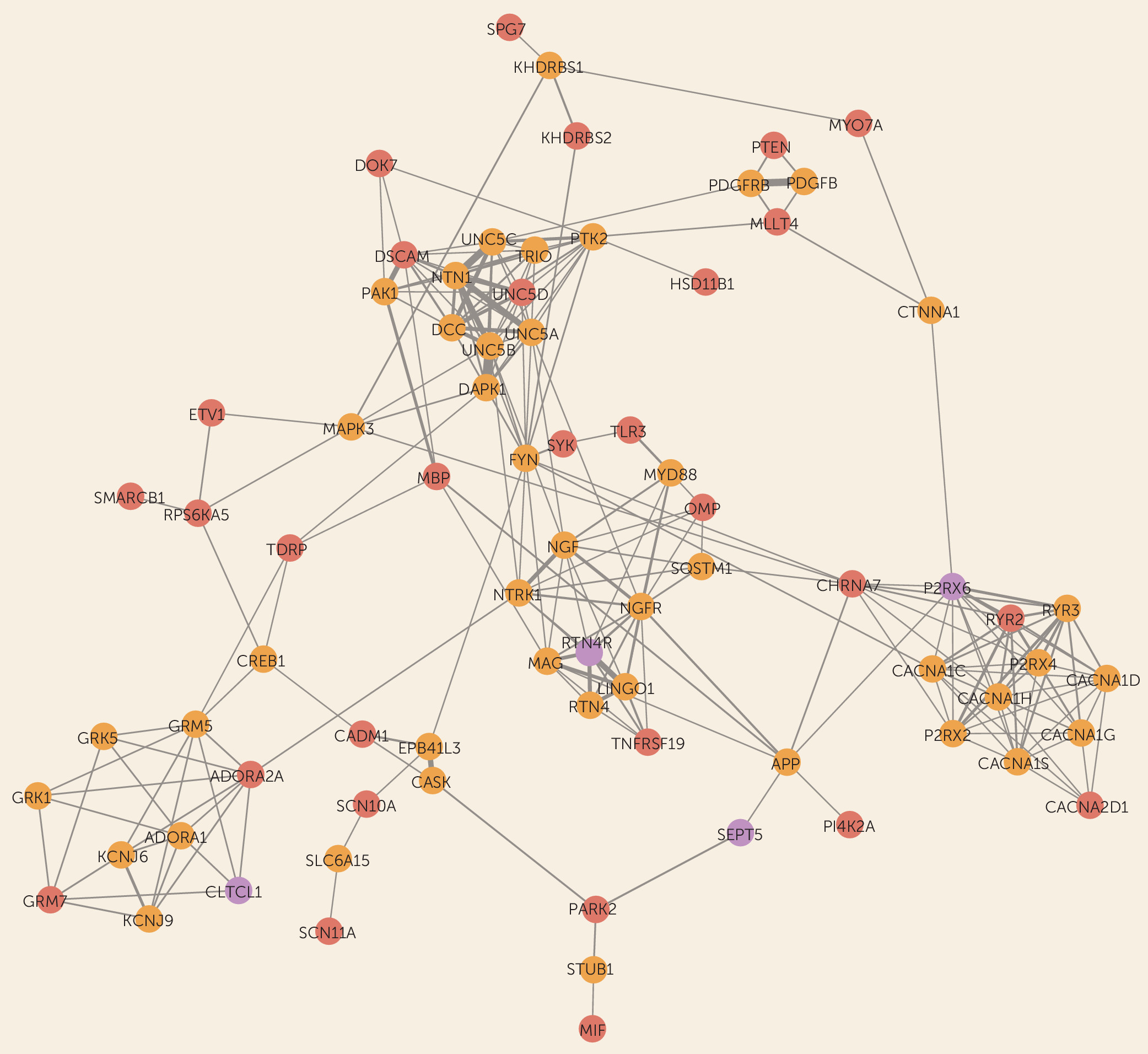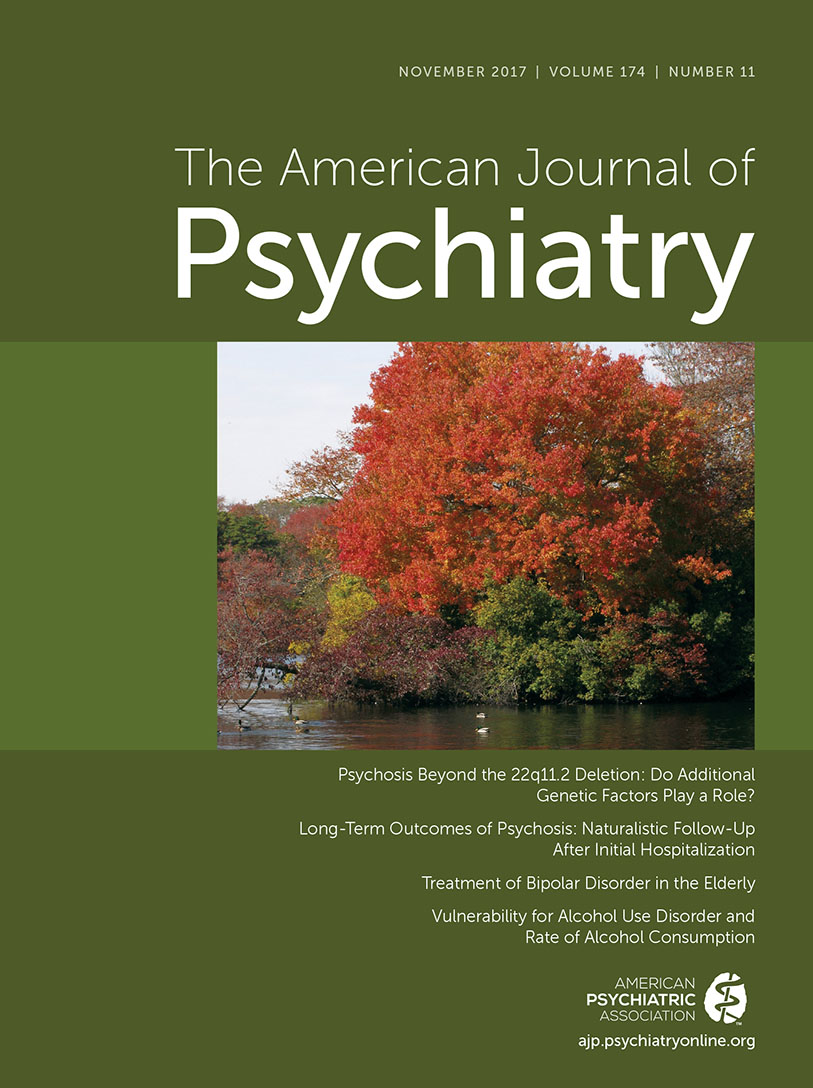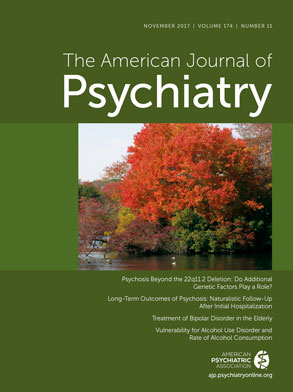Rare Genome-Wide Copy Number Variation and Expression of Schizophrenia in 22q11.2 Deletion Syndrome
Abstract
Objective:
Method:
Results:
Conclusions:
Method
Ascertainment of Samples From 22q11.2DS Subjects for CNV Data
Phenotype and Diagnostic Group Determination
CNV Detection and Annotation
CNV Burden Analysis and Statistical Approach
Gene Set Enrichment Analysis
Network Connectivity Test and Network Construction
Results
22q11.2 Deletions
Quantitative Genome-Wide Burden of Additional Rare CNVs
| Variable | 22q11.2DS-Schizophrenia (N=142)a | 22q11.2DS-Nonpsychotic (N=149)a | Analysis | |||
|---|---|---|---|---|---|---|
| Median | Range | Median | Range | z | p | |
| Deletion or duplication | 2 | 1–26 | 2 | 1–26 | 1.5787 | 0.1144 |
| Deletionb | 2 | 1–18 | 1 | 1–14 | 2.7569 | 0.0058 |
| Duplication | 2 | 1–26 | 2 | 1–26 | 0.1470 | 0.8831 |
Functional Burden of Additional Rare CNVs
| 22q11.2DS-Schizophrenia (N=142)b | 22q11.2DS-Nonpsychotic (N=149)b | Analyses | ||||||||
|---|---|---|---|---|---|---|---|---|---|---|
| Gene Set Name | Total Genes (N) | CNVs (N) | Subjects | CNVs (N) | Subjects | p | FDR-BH | Odds Ratio | ||
| N | % | N | % | |||||||
| Nervous system phenotype (MGI) | 2,609 | 37 | 32 | 22.5 | 16 | 15 | 10.1 | 0.00062 | 0.012 | 2.36 |
| Neurobehavioral phenotype (MGI) | 2,602 | 37 | 33 | 23.2 | 19 | 19 | 12.8 | 0.00174 | 0.016 | 2.21 |
| Neural phenotype union (MGI) | 3,764 | 48 | 42 | 29.6 | 25 | 24 | 16.1 | 0.00260 | 0.016 | 1.80 |
| Muscle/cardiovascular phenotype (MGI) | 2,327 | 27 | 25 | 17.6 | 13 | 13 | 8.7 | 0.00481 | 0.022 | 2.38 |
| Endocrine/exocrine/reproduction phenotype (MGI) | 2,298 | 31 | 31 | 21.8 | 18 | 17 | 11.4 | 0.01099 | 0.042 | 2.08 |
| Synaptic (Gene Ontology) | 860 | 15 | 14 | 9.9 | 6 | 6 | 4.0 | 0.02472 | 0.078 | 2.81 |
| CNV | Subject | Chromosome | Cytoband | Startb | Size | Genes (N) | Very Rare CNVc | Flanking Low-Copy Repeats | All Genes Overlapped by CNV | Gene(s) Contributing to Nervous System Gene Set Results |
|---|---|---|---|---|---|---|---|---|---|---|
| 1 | 17 | 1 | 1p22.1 | 94463617 | 18760 | 1 | • | ABCA4 | ABCA4 | |
| 2 | 130 | 1 | 1q32.2 | 209881045 | 28340 | 1 | • | HSD11B1 | HSD11B1 | |
| 3 | 93 | 1 | 1q43 | 237492310 | 26855 | 1 | • | RYR2 | RYR2 | |
| 4 | 144 | 2 | 2q35 | 216834680 | 340811 | 5 | • | TMEM169, MARCH4, PECR, XRCC5, MREG | XRCC5 | |
| 5 | 39 | 3 | 3p26.1 | 7619772 | 536651 | 1 | • | GRM7 | GRM7 | |
| 6 | 55 | 3 | 3p22.2 | 38608585 | 510439 | 4 | • | WDR48, SCN11A, SCN5A, SCN10A | SCN11A, SCN5A, SCN10A | |
| 7 | 28 | 3 | 3q29 | 195263161 | 232072 | 4 | APOD, MUC4, MUC20, PPP1R2, miR–570–5p, miR–570–3p | APOD | ||
| 8 | 130 | 4 | 4p16.3 | 3463452 | 10187 | 1 | • | DOK7 | DOK7 | |
| 9 | 42 | 4 | 4p15.2 | 26433603 | 49693 | 2 | • | RBPJ, CCKAR | CCKAR | |
| 10 | 65 | 4 | 4q35.1 | 186979699 | 76584 | 1 | TLR3 | TLR3 | ||
| 11 | 110 | 6 | 6q11.1 | 62234532 | 270027 | 2 | MTRNR2L9, KHDRBS2 | KHDRBS2 | ||
| 12 | 15 | 6 | 6q26 | 161687430 | 1202784 | 2 | • | AGPAT4, PARK2 | PARK2 | |
| 13 | 150 | 6 | 6q27 | 168167050 | 228482 | 2 | • | MLLT4, HGC6.3 | MLLT4 | |
| 14 | 141 | 7 | 7p21.2 | 13946099 | 33357 | 1 | • | ETV1 | ETV1 | |
| 15 | 55 | 7 | 7q21.11 | 81993260 | 185718 | 1 | CACNA2D1 | CACNA2D1 | ||
| 16 | 114 | 8 | 8p23.3 | 427857 | 77504 | 1 | • | TDRP | TDRP | |
| 17 | 127 | 8 | 8p22 | 13329776 | 290648 | 2 | • | DLC1, C8orf48 | DLC1 | |
| 18 | 110 | 8 | 8p12 | 34906448 | 250455 | 1 | • | UNC5D | UNC5D | |
| 19d | 143 | 8 | 8q12.1 | 56722133 | 159268 | 2 | LYN, TGS1 | LYN | ||
| 20 | 79 | 9 | 9q22.2 | 93616404 | 82699 | 1 | SYK | SYK | ||
| 21 | 10 | 10 | 10q23.31 | 89651696 | 46930 | 1 | • | PTEN | PTEN | |
| 22 | 35 | 10 | 10q24.2 | 99411165 | 39708 | 2 | AVPI1, PI4K2A | PI4K2A | ||
| 23 | 15 | 11 | 11q13.5 | 76735763 | 156340 | 4 | • | B3GNT6, OMP, MYO7A, CAPN5 | MYO7A, OMP | |
| 24 | 86 | 11 | 11q23.3 | 115010867 | 139977 | 1 | • | CADM1 | CADM1 | |
| 25 | 12 | 12 | 12q24.21, 12q24.22 | 116396113 | 1021914 | 6 | • | FBXW8, MAP1LC3B2, MED13L, RNFT2, C12orf49, HRK, miR–4472, miR–620 | FBXW8 | |
| 26 | 116 | 13 | 13q12.12 | 23397621 | 1690189 | 9 | • | SPATA13, C1QTNF9, C1QTNF9B, SGCG, C1Q, TNF9B-AS1, PARP4, MIPEP, SACS, TNFRSF19, miR–2276–5p, miR–2276–3p | C1QTNF9B, TNFRSF19 | |
| 27 | 30 | 14 | 14q32.11 | 91288380 | 77382 | 1 | • | RPS6KA5 | RPS6KA5 | |
| 28e | 92 | 15 | 15q13.2,15q13.3 | 30668479 | 1952748 | 9 | • | KLF13, OTUD7A, MTMR10, FAN1, CHRNA7, LOC283710, ARHGAP11B, TRPM1, CHRFAM7A, miR–211–5p, miR–211–3p | CHRNA7, TRPM1 | |
| 29e | 52 | 15 | 15q13.2,15q13.3 | 30747394 | 2129590 | 9 | • | KLF13, OTUD7A, MTMR10, FAN1, GOLGA8O, CHRNA7, LOC283710, ARHGAP11B, TRPM1, miR–211–5p, miR–211–3p | CHRNA7, TRPM1 | |
| 30 | 131 | 15 | 15q25.1 | 78421669 | 15345 | 1 | • | CIB2 | CIB2 | |
| 31 | 33 | 16 | 16q24.3 | 89420230 | 258822 | 4 | • | RPL13, SPG7, CPNE7, ANKRD11 | SPG7 | |
| 32d,e | 132 | 17 | 17q12 | 34816256 | 1428102 | 15 | • | ZNHIT3, LHX1, DUSP14, MRM1, ACACA, DDX52, DHRS11, SYNRG, C17orf78, HNF1B, AATF, MYO19, PIGW, TADA2A, GGNBP2, miR–378j, miR–2909 | LHX1 | |
| 33 | 147 | 18 | 18q23 | 74711326 | 80540 | 1 | • | MBP | MBP | |
| 34 | 34 | 20 | 20p13 | 4895803 | 181274 | 1 | • | SLC23A2 | SLC23A2 | |
| 35 | 130 | 20 | 20p11.21 | 25061344 | 198784 | 3 | • | ENTPD6, PYGB, VSX1 | VSX1 | |
| 36 | 41 | 21 | 21q22.2 | 41337036 | 120608 | 1 | • | DSCAM | DSCAM | |
| 37 | 121 | 22 | 22q11.23 | 23675258 | 1384582 | 26 | • | SMARCB1, MMP11, C22orf43, DDTL, RGL4, SLC2A11, MIF, CHCHD10, DERL3, C22orf15, IGLL1, GSTT2B, ZNF70, DDT, VPREB3, GSTT2, ADORA2A, SNRPD3, FAM211B, CABIN1, SPECC1L, GUCD1, SUSD2, GGT5, UPB1, GGT1 | ADORA2A, MIF, SMARCB1 |
Potential Mechanisms of Rare CNV-Related Risk for Schizophrenia in 22q11.2DS

Discussion
Advantages and Limitations
Acknowledgments
Supplementary Material
- View/Download
- 521.82 KB
- Download
- 83.68 KB
References
Information & Authors
Information
Published In
History
Keywords
Authors
Competing Interests
Funding Information
Metrics & Citations
Metrics
Citations
Export Citations
If you have the appropriate software installed, you can download article citation data to the citation manager of your choice. Simply select your manager software from the list below and click Download.
For more information or tips please see 'Downloading to a citation manager' in the Help menu.
View Options
View options
PDF/EPUB
View PDF/EPUBLogin options
Already a subscriber? Access your subscription through your login credentials or your institution for full access to this article.
Personal login Institutional Login Open Athens loginNot a subscriber?
PsychiatryOnline subscription options offer access to the DSM-5-TR® library, books, journals, CME, and patient resources. This all-in-one virtual library provides psychiatrists and mental health professionals with key resources for diagnosis, treatment, research, and professional development.
Need more help? PsychiatryOnline Customer Service may be reached by emailing [email protected] or by calling 800-368-5777 (in the U.S.) or 703-907-7322 (outside the U.S.).

